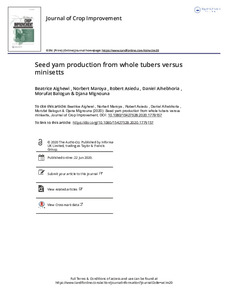| dc.contributor.author | Aighewi, B. |
| dc.contributor.author | Maroya, N. |
| dc.contributor.author | Asiedu, R. |
| dc.contributor.author | Aihebhoria, D. |
| dc.contributor.author | Balogun, M. |
| dc.contributor.author | Mignouna, D. |
| dc.date.accessioned | 2022-08-18T08:07:12Z |
| dc.date.available | 2022-08-18T08:07:12Z |
| dc.date.issued | 2020 |
| dc.identifier.citation | Aighewi, B., Maroya, N., Asiedu, R., Aihebhoria, D., Balogun, M. & Mignouna, D. (2020). Seed yam production from whole tubers versus minisetts. Journal of Crop Improvement,34(6),858-874. |
| dc.identifier.issn | 1542-7528 |
| dc.identifier.uri | https://hdl.handle.net/20.500.12478/7657 |
| dc.description.abstract | Yam (Dioscorea rotundata Poir.) is a major staple and cash crop for millions of households in West Africa, where about 93% of the world crop is produced. The tuber serves as food and seed. Depending on the size, seed tubers are often cut into setts, minisetts, or planted whole. An experiment was conducted to investigate the effects of using whole tubers versus minisetts to produce seed yams. Six treatments constituted combinations of whole tubers and minisetts, and three tuber-size classes, viz., 30–59 g, 60–89 g, and 90–120 g (averaged and referred to as 45 g, 75 g, and 105 g, respectively). The experiment was conducted as a randomized complete block design with three replications. Results showed that plants from whole tubers emerged from the soil faster and yielded 48% more than those from minisetts. The mean yield of 105 g minisetts (18.3 t/ha) was statistically similar to that of 45 g whole seed (17.9 t/ha). Using 45 g whole seed would save about 2 t/ha of the harvested crop for use as food instead of seed. So, planting small whole tubers is more profitable than minisetts and is recommended to yam growers. |
| dc.description.sponsorship | Bill & Melinda Gates Foundation |
| dc.format.extent | 858-874 |
| dc.language.iso | en |
| dc.subject | Yams |
| dc.subject | Dioscorea |
| dc.subject | Micropropagation |
| dc.subject | Seed Set |
| dc.subject | Production |
| dc.subject | West Africa |
| dc.title | Seed yam production from whole tubers versus minisetts |
| dc.type | Journal Article |
| cg.contributor.crp | Roots, Tubers and Bananas |
| cg.contributor.affiliation | International Institute of Tropical Agriculture |
| cg.contributor.affiliation | University of Ibadan |
| cg.coverage.region | Africa |
| cg.coverage.region | West Africa |
| cg.coverage.country | Cote d’Ivoire (Ivory Coast) |
| cg.coverage.country | Ghana |
| cg.coverage.country | Nigeria |
| cg.coverage.hub | Headquarters and Western Africa Hub |
| cg.researchtheme | Biotech and Plant Breeding |
| cg.researchtheme | Plant Production and Health |
| cg.researchtheme | Social Science and Agribusiness |
| cg.identifier.bibtexciteid | AIGHEWI:2020a |
| cg.isijournal | ISI Journal |
| cg.authorship.types | CGIAR Single Centre |
| cg.iitasubject | Agribusiness |
| cg.iitasubject | Agronomy |
| cg.iitasubject | Plant Breeding |
| cg.iitasubject | Plant Production |
| cg.iitasubject | Yam |
| cg.journal | Journal of Crop Improvement |
| cg.notes | Published online: 22 June 2020 |
| cg.accessibilitystatus | Open Access |
| cg.reviewstatus | Peer Review |
| cg.usagerightslicense | Creative Commons Attribution 4.0 (CC BY 0.0) |
| cg.targetaudience | Scientists |
| cg.identifier.doi | https://dx.doi.org/10.1080/15427528.2020.1779157 |
| cg.iitaauthor.identifier | Beatrice Aighewi: 0000-0002-9398-1674 |
| cg.iitaauthor.identifier | Norbert Maroya: 0000-0002-7079-4729 |
| cg.iitaauthor.identifier | Robert Asiedu: 0000-0001-8943-2376 |
| cg.iitaauthor.identifier | Morufat Balogun: 0000-0001-8770-5529 |
| cg.iitaauthor.identifier | Djana Babatima Mignouna: 0000-0002-4074-2928 |
| cg.futureupdate.required | No |
| cg.identifier.issue | 6 |
| cg.identifier.volume | 34 |

